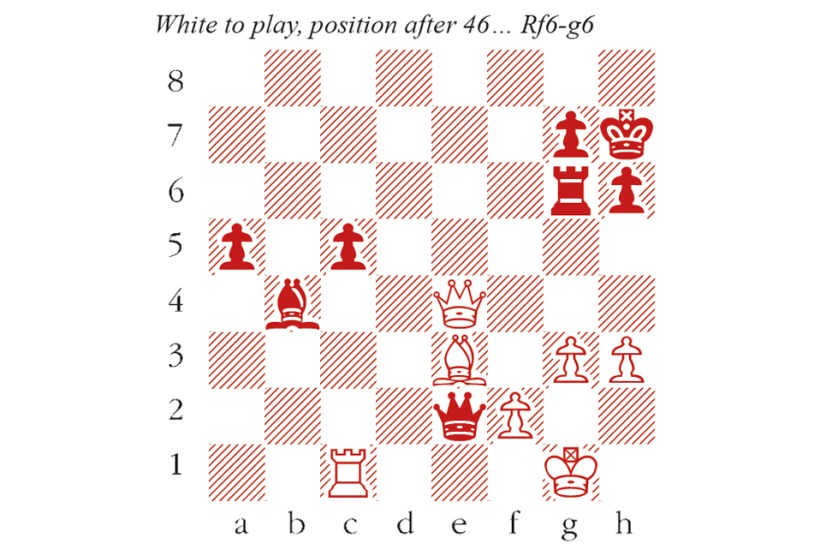Ding Liren from China has become the 17th world champion, defeating the Russian Ian Nepomniachtchi in Astana. The 14-game classical match saw triumph and tragedy on both sides, with six decisive games. But with honours shared at 7-7, the classical world championship was to be decided in a four-game rapid tiebreak, just as it was in 2006, 2012, 2016 and 2018.
The first three were drawn, and the fourth game looked bound for the same result, which would have led to a play-off at even faster time limits. But with both players down to their last minutes, Ding took an unexpected decision to prolong the fight instead of acceding to a draw. His courage was rewarded with an immediate mistake from Nepo, which confirmed my assessment four weeks ago that ‘Ding’s play stands out for his capacity to endure tension for longer than his opponents’.
Magnus Carlsen tweeted his approval, right after Ding won the game and the match: ‘Self-pinning for immortality. Congrats Ding!!’ Carlsen referenced the position in the diagram, where Ding has just played46…Rf6-g6!, avoiding the draw by repetition which looked inevitable in case of 46…Kg8. Many commentators had dismissed the move, because the rook looks precarious, like a football on top of an eggcup, and the simple plan of Qe4-f5 and h3-h4-h5 looks awkward to meet.
After a plausible continuation such as 47 h4 h5 48 Rc2 Qg4 49 Qd3 Kh8 50 Bxc5 Rc6 51 Rc4 Qg6 52 Qxg6 Rxg6 53 Bxb4 axb4 54 Rxb4, White’s extra pawn confers only a symbolic advantage, and a draw would be a near certainty.
But Nepo’s choice 47 Qf5 was a serious error. After 47…c4! 48 h4 Qd3, White’s queen was shaken off the crucial diagonal, and Ding assumed control, winning the game and tiebreak by 2.5-1.5.
Ian Nepomniachtchi–Ding Liren
Fide World Championship Tiebreak, Game 4, Astana 2023
1 e4 e5 2 Nf3 Nc6 3 Bb5 a6 4 Ba4 Nf6 5 O-O Be7 6 d3 b5 7 Bb3 d6 8 a4 Bd7 9 h3 O-O 10 Be3 Na5 11 Ba2 bxa4 12 Nc3 Rb8 13 Bb1 Qe8. A curious situation. White will soon recover the pawn, but the Bb1 will be interred for some time. The middlegame is complex but roughly balanced throughout. 14 b3 c5 15 Nxa4 Nc6 16 Nc3 a5 17 Nd2 Be6 18 Nc4 d5 19 exd5 Nxd5 20 Bd2 Nxc3 21 Bxc3 Bxc4 22 bxc4 Bd8 23 Bd2 Bc7 24 c3 f5 25 Re1 Rd8 26 Ra2 Qg6 27 Qe2 Qd6 28 g3 Rde8 29 Qf3 e4 30 dxe4 Ne5 31 Qg2 Nd3 32 Bxd3 Qxd3 33 exf5 Rxe1+ 34 Bxe1 Qxc4 35 Ra1 Rxf5 36 Bd2 h6 37 Qc6 Rf7 38 Re1 Kh7 39 Be3 Be5 40 Qe8 Bxc3. Well calculated. The ensuing pin is uncomfortable, but cannot be exploited. 41 Rc1 Rf6 42 Qd7 Qe2. An important trick, since 43 Rxc3 Qe1+ wins the rook. 43 Qd5 Bb4. I expected 43…Bd4 44 Bxd4 cxd4 45 Qxd4 and a draw soon after. Ding’s move is more ambitious: after 44 Bxc5 Be1! 45 Qg2 Bd2 only Black has chances. 44 Qe4+ Kg8 45 Qd5+ Kh7 46 Qe4+ Rg6 (see diagram)
47 Qf5 c4 48 h4 Qd3 49 Qf3 Rf6 50 Qg4 c3 51 Rd1 Qg6 52 Qc8 Rc6 53 Qa8 Rd6 54 Rxd6 Qxd6 55 Qe4+ Qg6 56 Qc4 Qb1+ 57 Kh2 a4 58 Bd4 a3 59 Qc7. Surprisingly, 59 Bxg7! Kxg7 60 Qd4+ leads to a draw by perpetual check. The key insight is that …Kb5 will be met by Qe8+, …Ka5 with Qa8+ and …Kc4 with Qe6+, and …Kd3 will lose the queen to a skewer. Qg6 Now White gets no more chances. 60 Qc4 c2 61 Be3 Bd6 62 Kg2 h5 63 Kf1 Be5 64 g4 hxg4 65 h5 Qf5 66 Qd5 g3 67 f4 a2 68 Qxa2 Bxf4 White resigns.
Got something to add? Join the discussion and comment below.
Get 10 issues for just $10
Subscribe to The Spectator Australia today for the next 10 magazine issues, plus full online access, for just $10.
You might disagree with half of it, but you’ll enjoy reading all of it. Try your first month for free, then just $2 a week for the remainder of your first year.








Comments
Don't miss out
Join the conversation with other Spectator Australia readers. Subscribe to leave a comment.
SUBSCRIBEAlready a subscriber? Log in